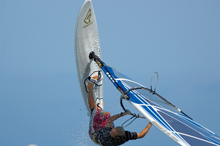Another board into its second year on the catalogue. It is billed as a “radical” waveboard for “good wave conditions” but qualified as being “user friendly”. The reason it is included here is more as a single fin counterpoint to the two twinsers and as a waveboard comparison to the small freestyle-waves in onshore conditions. It was included because it fared so well in 75L in our early season wave test.
Design: Compared to the freestyle-waves (and to the waveboards) the 81 is more tapered down at nose and tail. It is similarly wide at max but as you might expect it has ‘proper’ waveboard quantities of rocker with the most tail rocker (12mm) and one of the shortest planing flats (2cm point at 140cm from the tail). Surprisingly it is the only board on test to feature single concave, having pronounced single concave all the way to the tail.
On the water: Although it couldn’t hope to compete with the freestyle-waves with 5.7m sails for jumping and blasting about in moderate winds we were surprised how well it reacted once the 5.4m wind threshold had been reached. Actually, perhaps we shouldn’t have been surprised given the excellent acceleration of the 75L in our wave test earlier this year, but it rarely came off the plane and once going didn’t seem to drag back unless there was a big lull. In other words it feels fast for a proper waveboard.
It feels extremely lively and quick to turn, reacting immediately and much more snappily than the FSWs. Compared to the twinsers it felt more nippy and agile on the tail, not as slashy and pivotal but grippier (despite the single concave) when going out through the break and clearly easier to push hard into jumps. It also felt much more secure in carving turns but considerably more likely to stall in underpowered waveriding; less loose and redirectable than the RRD Wave Twin and less tight and slashy than the Mistral Twinzer, but more immediately agile and responsive than either.

Fittings: Straps and pads as for the Freewave though there is less dome to the deck. The classic 23.5cm G10 fin suits the board well.
Overall: It would be unfair to treat this as a comprehensive test of the 81 since it is not principally designed for such onshore conditions and was not tested with its peers. Nevertheless, it proved very suitable for jumping and offered excellent control when the wind was strong, along with tight reliable gybing. It clearly would be great fun to ride in more cross-shore conditions, but waveboards like these suffer a bit when they need to keep speed over so protracted a bottom turn without the power of the wave. They are also less slashy in small waves. What they offer is greater precision and control under high power.
We were also pleasantly surprised by how well the 81 competed once the wind had got up, feeling fast, exciting and responsive. It proved a favourite with our lightweight guester and depending on wind strength and conditions could be the most fun of all to jump with and blast and gybe through the break.
Although also popular with lighter riders we would particularly recommend it for advanced heavier sailors (78-88kg) for stronger winds and good waves and believe it would be very competitive against its peers in this category.





